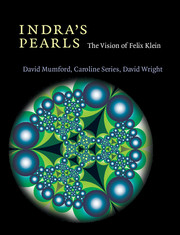Book contents
- Frontmatter
- Contents
- Preface
- Introduction
- 1 The language of symmetry
- 2 A delightful fiction
- 3 Double spirals and Möbius maps
- 4 The Schottky dance pages 96 to 107
- 4 The Schottky dance pages 107 to 120
- 5 Fractal dust and infinite words
- 6 Indra's necklace
- 7 The glowing gasket
- 8 Playing with parameters pages 224 to 244
- 8 Playing with parameters pages 245 to 267
- 9 Accidents will happen pages 268 to 291
- 9 Accidents will happen pages 291 to 296
- 9 Accidents will happen pages 296 to 309
- 10 Between the cracks pages 310 to 320
- 10 Between the cracks pages 320 to 330
- 10 Between the cracks pages 331 to 340
- 10 Between the cracks pages 340 to 345
- 10 Between the cracks pages 345 to 352
- 11 Crossing boundaries pages 353 to 365
- 11 Crossing boundaries 365 to 372
- 12 Epilogue
- Index
- Road map
2 - A delightful fiction
Published online by Cambridge University Press: 05 January 2014
- Frontmatter
- Contents
- Preface
- Introduction
- 1 The language of symmetry
- 2 A delightful fiction
- 3 Double spirals and Möbius maps
- 4 The Schottky dance pages 96 to 107
- 4 The Schottky dance pages 107 to 120
- 5 Fractal dust and infinite words
- 6 Indra's necklace
- 7 The glowing gasket
- 8 Playing with parameters pages 224 to 244
- 8 Playing with parameters pages 245 to 267
- 9 Accidents will happen pages 268 to 291
- 9 Accidents will happen pages 291 to 296
- 9 Accidents will happen pages 296 to 309
- 10 Between the cracks pages 310 to 320
- 10 Between the cracks pages 320 to 330
- 10 Between the cracks pages 331 to 340
- 10 Between the cracks pages 340 to 345
- 10 Between the cracks pages 345 to 352
- 11 Crossing boundaries pages 353 to 365
- 11 Crossing boundaries 365 to 372
- 12 Epilogue
- Index
- Road map
Summary
So progresses arithmetic subtlety,
the end of which, as is said, is as refined as it is useless.
Ars Magna, Girolamo CardanoThe intricate fractal shapes we are aiming to draw are based on the algebra and geometry of complex numbers. Complex numbers are really not as complex as you might expect from their name, particularly if we think of them in terms of the underlying two dimensional geometry which they describe. Perhaps it would have been better to call them ‘nature's numbers’. Behind complex numbers is a wonderful synthesis between two dimensional geometry and an elegant arithmetic in which every polynomial equation has a solution. When complex numbers were first dreamed of in the Renaissance, they were treated as an esoteric, almost mystical, concept. This aura of mystery persisted well into the twentieth century – the senior author's aunt Margaret Silcock (née Mumford), who studied mathematics at Girton College Cambridge in 1916, liked to describe them as a ‘delightful fiction’. In fact we still use the term ‘imaginary numbers’ to this day. Modern scientists, however, take complex numbers for granted, FORTRAN makes them a predefined data type, and they are standard toolkit for any electronic engineer. Perhaps the most remarkable fact about complex numbers is that they are absolutely essential to modern physics. In the theory of quantum mechanics, not only can the universe exist probabilistically in two states at once, but the uncertain composite state is constructed by adding the two simple states together with complex coefficients, introducing a complex ‘phase’.
- Type
- Chapter
- Information
- Indra's PearlsThe Vision of Felix Klein, pp. 36 - 61Publisher: Cambridge University PressPrint publication year: 2002

